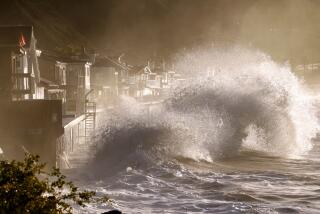Two Chances for Relief: Slim and None
- Share via
Meteorologists warned Tuesday that the Midwest is not out of trouble, despite hopes that a crest in record Mississippi River levels would spell an end to the devastating floods that have caused billions of dollars in structural damage and crop losses.
Conditions that caused the flooding still stubbornly hover in the atmosphere, feeding extra moisture to routine summer thunderstorms that have been rolling into Missouri and Iowa. Storms dumped three inches of rain Tuesday and more is forecast daily in the National Meteorological Center’s five-day outlook.
“That whole region that has been in big trouble is in for more rain,” said Bruce Terry, the lead forecaster at the center in Camp Springs, Md. “It won’t be in the same place everyday, but it will be rather heavy.”
With the saturated soil unable to absorb any more water, these new storms were expected to push the Mississippi River at St. Louis to a new record height of 47 feet by midnight Tuesday, said Mark Bogner, a meteorologist for the private Wichita, Kan., forecast company WeatherData Inc.
These catastrophic rains are due to an unusual convergence of weather phenomena from two oceans--a persistent El Nino in the Pacific and a wandering Bermuda High from the Atlantic.
El Nino, which brings warm water from the Philippines to the equatorial eastern Pacific Ocean, evidently has encouraged a moisture-laden high-level tropical jet stream from Baja California to invade the Midwest.
Meanwhile, closer to the ground, the Bermuda High, a mass of air under unusually high pressure, has migrated west from Bermuda and become stuck over the continental United States. Clockwise-spinning winds off this high-pressure mass have been sweeping additional moisture from the Gulf of Mexico and into the Midwest.
Adding to this is another, albeit weaker, flow of moisture up from Mexico itself.
“When one of these sources has broken off, it seems that another is right there to take its place,” said Bogner.
What’s worse, he said, is that there is no relief in sight.
It would take a particularly strong event to break this pattern, he said. But such relief--most likely in the form of a powerful cold front moving down from Canada or a hurricane racing in from the Atlantic--usually does not appear until the end of August or September.
Other meteorologists suggested that the start of “monsoons,” or summer thunderstorms, in Arizona could help relieve the Midwest by siphoning off moisture from the Gulf. These Arizona storms traditionally arrive in August.
Of all the weather influences contributing to the Midwest flood disaster, the long-running El Nino may be most to blame, meteorologists said. The warm-ocean phenomenon began early in 1992, and by the end of the year was bringing drought-busting rains to a historically parched California.
Although the El Nino effect increases the average ocean temperature only about 2 degrees, it is enough to put measurably more water vapor in the atmosphere and redirect jet streams so that rain falls over North America.
Earlier this year, a new Franco-American satellite detected a fresh pulse of warm water moving eastward across the Pacific Ocean toward Ecuador and Peru. This warm water renewed El Nino, which continued to send unusual amounts of rain toward the Midwest in a tropical jet stream about 15,000 feet high.
Low-level moisture brought up by the Bermuda High began supplementing this conveyor belt of rain earlier this month, dumping even more rain on saturated soil.
Extended El Nino effects are not unknown, said Carlos Mechoso, an associate professor of meteorology at UCLA, but scientists are at a loss to explain why some last longer than others.
El Ninos, so named because they were first observed near Christmas (“el nino” is Spanish for “the boy,” or the newborn Christ), occurred in 1982-83 and 1986-87. On both occasions, they produced prodigious rains in the Southwest.
More to Read
Sign up for Essential California
The most important California stories and recommendations in your inbox every morning.
You may occasionally receive promotional content from the Los Angeles Times.













